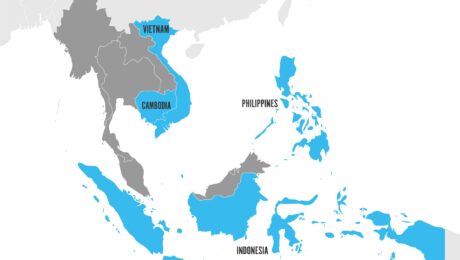Indonesia Webinar Workshop
- Published in All Reports, Indonesia All Reports, Indonesia Workshops, Workshops
Regional Webinar Workshop
- Published in All Reports, Workshops
Executive Summary – Cambodia (English and Khmer)
Based on the five pillars of the ADB EdTech Readiness Framework, this report describes the current situation of education in Cambodia in general, with a specific focus on how EdTech is being implemented to improve the quality of teaching and learning. The five pillars of the framework include infrastructure, government, schools/teachers, parents/students, and EdTech providers. By identifying the existing status of EdTech readiness in Cambodia using this framework, the report seeks to provide evidence against which decision-makers can identify initiatives likely to make a positive contribution to the quality of the education ecosystem and opportunities for public-private partnerships. Cambodia had a population of 16.83 million people in January 2021 (51.2% of Cambodia’s population is female) and 8.86 million internet users in January 2021, giving it a 52.6% internet penetration rate1 . In 2021 Cambodia had 12.00 million social media users (equal to 71.3% of the population). Cambodia is ranked 106th out of 130 economies in the Network Readiness Index (NRI) 2021, with impact (quality of life) as its key strength and governance as its main weakness (trust). An account of the gender gap in EdTech is included in Annex 3) of this report. In brief its findings are that the Royal Government of Cambodia is committed to gender equality and over the past five years the proportion of women who are in the workforce has increased by 5% to 84%; but female’s opportunities in EdTech are largely limited by cultural and family beliefs and values that see EdTech as being a male dominated field. Notwithstanding this, in Upper Secondary Schools the proportion of girls remaining is education is higher (54%) than boys (46%) and girls are increasingly opting for STEM subjects – though they are then more likely to follow science than technology options at university. More women are now becoming self-employed (65% of all SMEs are now owned and run by women) and their skills in using online eCommerce opportunities is a critical success factor here. In general women teachers have lower EdTech skills than men and lower levels of digital literacy. Although in general, across the country, smartphone ownership is high, rural women are the least likely segment of the population to own a cellphone.
Download the full report
- Published in All Reports, Cambodia All Reports, Cambodia Summary, Summary
Executive Summary – Indonesia (English and Indonesian)
Based on the five pillars of the ADB EdTech Readiness Framework, this report describes the current situation of education in Indonesia in general, with a specific focus on how EdTech is being implemented to improve the quality of teaching and learning. The five pillars of the framework include infrastructure, government, schools/teachers, parents/students, and EdTech providers. By identifying the existing status of EdTech readiness in Indonesia using this framework, the report seeks to provide evidence against which decision-makers can identify initiatives likely to make a positive contribution to the quality of the education ecosystem and opportunities for public-private partnerships.
Download the full report
- Published in All Reports, Indonesia All Reports, Indonesia Summary, Summary
Executive Summary – Philippines (English and Tagalog)
Based on the five pillars of the ADB EdTech Readiness Framework, this report describes the current situation of education in Philippines in general, with a specific focus on how EdTech in being implemented to improve the quality of teaching and learning. The five pillars include infrastructure, government, schools/teachers, parents/students, and EdTech providers. By identifying the existing status of EdTech readiness, the report seeks to provide evidence against which decision-makers can identify initiatives likely to make a positive contribution to the quality of the education ecosystem and opportunities for public-private partnerships. The TIESEA team, as part of the study in the Philippines, also undertook a gender analysis and the report is presented in full in Annex 3. Historically, the education system in the Philippines favored males over the females, but from the 1970s onwards the number of college-educated women began to surpass that of men. It is reported that, currently, the number of girls completing secondary education surpasses that of boys by 12%. The Philippines is the only country in Asia to be in the top twenty for gender parity, though there is an underrepresentation of girls and women in the technology sectors, mostly due to cultural traditions and family preferences. Nonetheless, there are proportionally more women in the service sectors of the economy where there is often a high reliance on ICT skills. In contrast to international averages where, typically women’s aggregate wages are 20% lower than men’s, in Philippines women’s earnings are, when taken as a whole, are 10% higher. Although a great majority of female entrepreneurs operate in the small to medium enterprise (SME) sectors only a small proportion of them have had any training about harnessing technology as part of entrepreneurship training. This is despite man campaigns to promote women’s expertise in ICT. Nonetheless, recent government policy moves have resulted in increasing numbers of women enrolling in STEM-related disciplines at university level.
Download the full report
- Published in All Reports, Philippines All Reports, Philippines Summary, Summary
Executive Summary – Viet Nam (English and Vietnamese)
Viet Nam’s K-12 sector consists of more than 15.8 million students (8 million in primary, 5.3 million in lower secondary, and 2.5 million in upper secondary) General education (grade 1-12) has undergone significant reform in recent years. For instance, a new competency-based curriculum has replaced conventional delivery based on a single set of textbooks, and attempts to integrate STEM/STEAM into the curriculum have put strong emphasis on innovative pedagogy. Gender disparities exist in Viet Nam, but they are shrinking (see Annex 3) currently more girls than boys are enrolling for upper secondary education and the graduation rate for Bachelors degrees has reached gender parity Women, in general, are earning about 10% less than men for equivalent work. Based on the five pillars of the ADB EdTech Readiness Framework, this report describes the current situation of education in Viet Nam in general, with a specific focus on how EdTech is being implemented to improve the quality of teaching and learning. The five pillars of the framework include infrastructure, government, schools/teachers, parents/students, and EdTech providers. By identifying the existing status of EdTech readiness in Viet Nam using this framework, the report seeks to provide evidence against which decision-makers can identify initiatives likely to make a positive contribution to the quality of the education ecosystem and opportunities for public-private partnerships.
Download the full report
- Published in All Reports, Summary, Vietnam All Reports, Vietnam Summary
Report on Knowledge Sharing and Ideation Country Workshops and Regional Workshop April 2022
The aim of the TIESEA project is to identify what works in Education Technology (EdTech) in the context of the four countries where the project is operating: Cambodia, Indonesia, Philippines, and Viet Nam. Based on a landscape review of existing EdTech in each country and an assessment of supporting infrastructure as well as teacher, student, and parent capacity, a single intervention will be designed for each country. These pilot interventions will run in each of the countries for one year, and the impact on educational attainment and the quality of learning will be rigorously evaluated. The project will also undertake capacity-building workshops and host a major international conference during 2023 to share the findings of the project and to disseminate more widely the strengths and areas for
development in the key interfaces between schools, homes, families, and technology.
Download the full report
Report on Knowledge Sharing and Ideation Country Workshops and Regional Workshop
Diagnostic Assessment Report – Viet Nam Country Report March 2022
Viet Nam’s K-12 sector consists of more than 15.8 million students (8 million in primary, 5.3 million in lower secondary, and 2.5 million in upper secondary) General education (grade 1-12) has undergone significant reform in recent years. For instance, a new competency-based curriculum has replaced conventional delivery based on a single set of textbooks, and attempts to integrate STEM/STEAM into the curriculum have put strong emphasis on innovative pedagogy. Gender disparities exist in Viet Nam, but they are shrinking (see Annex 3) currently more girls than boys are enrolling for upper secondary education and the graduation rate for Bachelors degrees has reached gender parity Women, in general, are earning about 10% less than men for equivalent work. Based on the five pillars of the ADB EdTech Readiness Framework, this report describes the current situation of education in Viet Nam in general, with a specific focus on how EdTech is being implemented to improve the quality of teaching and learning. The five pillars of the framework include infrastructure, government, schools/teachers, parents/students, and EdTech providers. By identifying the existing status of EdTech readiness in Viet Nam using this framework, the report seeks to provide evidence against which decision-makers can identify initiatives likely to make a positive contribution to the quality of the education ecosystem and opportunities for public-private partnerships.
Download the full report
- Published in All Reports, Reports, Vietnam All Reports, Vietnam Reports
Diagnostic Assessment Report – Philippines Country Report March 2022
Based on the five pillars of the ADB EdTech Readiness Framework, this report describes the current situation of education in Philippines in general, with a specific focus on how EdTech in being implemented to improve the quality of teaching and learning. The five pillars include infrastructure, government, schools/teachers, parents/students, and EdTech providers. By identifying the existing status of EdTech readiness, the report seeks to provide evidence against which decision-makers can identify initiatives likely to make a positive contribution to the quality of the education ecosystem and opportunities for public-private partnerships. The TIESEA team, as part of the study in the Philippines, also undertook a gender analysis and the report is presented in full in Annex 3. Historically, the education system in the Philippines favored males over the females, but from the 1970s onwards the number of college-educated women began to surpass that of men. It is reported that, currently, the number of girls completing secondary education surpasses that of boys by 12%. The Philippines is the only country in Asia to be in the top twenty for gender parity, though there is an underrepresentation of girls and women in the technology sectors, mostly due to cultural traditions and family preferences. Nonetheless, there are proportionally more women in the service sectors of the economy where there is often a high reliance on ICT skills. In contrast to international averages where, typically women’s aggregate wages are 20% lower than men’s, in Philippines women’s earnings are, when taken as a whole, are 10% higher. Although a great majority of female entrepreneurs operate in the small to medium enterprise (SME) sectors only a small proportion of them have had any training about harnessing technology as part of entrepreneurship training. This is despite man campaigns to promote women’s expertise in ICT. Nonetheless, recent government policy moves have resulted in increasing numbers of women enrolling in STEM-related disciplines at university level.
Download the full report
- Published in All Reports, Philippines All Reports, Philippines Reports, Reports
Diagnostic Assessment Report – Indonesia Country Report March 2022
Based on the five pillars of the ADB EdTech Readiness Framework, this report describes the current situation of education in Indonesia in general, with a specific focus on how EdTech is being implemented to improve the quality of teaching and learning. The five pillars of the framework include infrastructure, government, schools/teachers, parents/students, and EdTech providers. By identifying the existing status of EdTech readiness in Indonesia using this framework, the report seeks to provide evidence against which decision-makers can identify initiatives likely to make a positive contribution to the quality of the education ecosystem and opportunities for public-private partnerships
Download the full report
- Published in All Reports, Indonesia All Reports, Indonesia Reports, Reports









